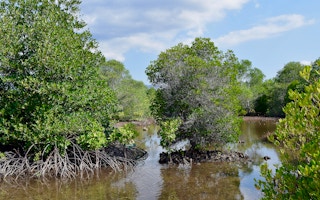Rising temperatures, changes in rainfall patterns and intensity and the increasing frequency of extreme weather events mean investing in climate-resilient infrastructure is critical. However, infrastructure remains far from adequate in many countries in Asia, despite the rapid economic growth and development the region has experienced over the past decade.
To continue reading, subscribe to Eco‑Business.
There's something for everyone. We offer a range of subscription plans.
- Access our stories and receive our Insights Weekly newsletter with the free EB Member plan.
- Unlock unlimited access to our content and archive with EB Circle.
- Publish your content with EB Premium.
The Asian Development Bank estimates that the region needs to invest US$1.7 trillion annually over the period spanning 2016 to 2030 to plug the infrastructure gap, maintain growth momentum and respond to climate change. The power and transport sectors account for most of the budgetary requirements, according to the bank.
However, with governments under fiscal pressure due to the ongoing Covid-19 pandemic, it is crucial that investments are sustainable. In an interview with Eco-Business, Thomas Walenta, senior investment officer from Asian Infrastructure Investment Bank (AIIB) explains the importance of building future-ready infrastructure and the role of intra-regional collaboration to address the needs for financing and project management expertise.
The US$1.7 trillion that is needed each year to plug the infrastructure gap in Asia is a lot of money. How far away is Asia from raising that money? And how good is the region at spending it where it is needed?
When we talk about this large number, that doesn’t mean that there is US$1.7 trillion worth of infrastructure projects laying on the street and you just need to allocate capital to it. The number is suggesting that this is the demand. So you need institutions like AIIB that can help make bankable projects out of these demands so that they can attract capital to finance them. This number is just so vast that public sources alone can’t really do that. We have to catalyse private capital to flow into what we believe are good investments.
An organisation like AIIB was set up to help facilitate these vast pockets of capital that we find, not just in North America and Europe, but also here in Asia and then make sure that this capital is also invested in the region. We therefore continue to prioritise projects that complement cross-border infrastructure connectivity by generating direct measurable benefits in enhancing regional trade, investment, digital and financial integration across Asian economies and beyond.

Thomas Walenta, senior investment officer, Asian Infrastructure Investment Bank (AIIB)
In countries where there is immediate need for infrastructure, how do you ensure that it is sustainable and climate resilient?
We pushed our definition of infrastructure out earlier this year - ‘Infrastructure for Tomorrow’ - meaning infrastructure with sustainability at its core. We were seeing certain trends and disruptions, before the Covid-19 pandemic hit us, where there’s concern about future infrastructure needs. Infrastructure for Tomorrow is a dynamic concept that will be shaped by rapid changes in the way markets function and people live, move and work. What is built, how it is built and where it is built will evolve as the needs of the people, economy and the world change and as infrastructure techniques advance. AIIB will focus on financing Infrastructure for Tomorrow, unlocking new capital, new technologies and new ways to address climate change and to connect Asia, and the world.
How do you reconcile this huge push to build infrastructure with the challenge of keeping the emissions down without resorting to offsets?
What we do as a financier is, we weigh different impacts against each other. Whenever you invest in infrastructure, there are negative impacts. We have developed an environmental and social framework that addresses these issues, according to the highest international standards. When we invest in infrastructure, we try to minimise the carbon footprint as much as possible, but we also try to focus on infrastructure that potentially can help, for example, get access to electricity, without any carbon footprint, because of the technologies that are being used. The international discussion is mostly on climate mitigation, and there’s very little capital going into climate adaptation and resilience.
Why is climate resilience not getting enough capital?
The focus is trying limit the harm that we are doing right now, which is maybe why the focus is more on mitigation than on adaptation. But the closer we get to a scenario where the mitigation efforts can’t really move the needle anymore, we will probably shift towards adaptation. Some nature-based solutions such as coastline engagement for example, are not as visible. Most investors with long-term investment horizons now recognise that climate resilience will have an impact on financial markets and their portfolios. However, investors do not sufficiently take the risks into account as they materialise only over a long horizon, as a result of the “tragedy of the horizon” as Mark Carney, the governor of the Bank of England, put it. AIIB is committed to climate finance and will aim at reaching or surpassing by 2025 a 50 per cent share of climate finance in its actual financing approvals, which includes financing toward both climate mitigation and climate adaptation.
“
The international discussion is mostly on climate mitigation, and there’s very little capital going into climate adaptation and resilience.
Thomas Walenta, senior investment officer, Asian Infrastructure Investment Bank
Where do you see a lot of progress being made in the region? Is there a market that investors seem to be particularly interested in?
I think there are so many bright spots. If you look at South Asia, Southeast Asia, East Asia, that’s probably where all the dynamics are. Private investors are less focused on Central Asia, it’s a challenging market to operate in and at times more difficult to get the right returns, especially in hard currency. China and India are traditionally sweet spots for investors, because you have the scale, regulatory environment, political stability and long-term economic growth that is needed. But more capital is flowing into Indonesia and Vietnam. Where it’s a bit more challenging is the low-income countries which have been hard hit by the Covid-19 pandemic and often do not have the fiscal space, that high income countries may have, to react.
In terms of regulation and governance that ensures that finance is really ‘sustainable’, does Asia have some catching up to do compared to its European counterparts?
I think we have an abundancy of frameworks with so many different decentralised players using different terminology. For private capital and investors, they like it simple and to have something that is investable. It is easier when you have credit rating agencies that rate your bonds that are then highly correlated in terms of how their ratings work. And so, you have very clearly defined asset classes with very clearly defined regulations. But now, we are entering in a space where we have so much terminology and so many different products; it’s ESG (environmental, social, governance), it’s responsible, it’s socially responsible, it’s ethical, it’s sustainable - where I think it’s just so confusing for people.
You have different industry associations trying to pull it all together, but actually creating different competing frameworks. You still see a lot of ESG ratings that are uncorrelated, just because of the methodology that they use or because of what they want to bring to investors’ attention. That makes it very difficult for a typical asset owner to allocate capital. But we can see more standardisation happening. We want to be part of that because we want to make it easy for investors to allocate capital where they know what’s going to happen with it.
It is important that a framework is coherent and objective, but it should also take into account the local context. It doesn’t make any sense to have a framework that proclaims the highest standards but isn’t used by anybody because it doesn’t really match the realities on the ground.
What is your outlook leading up to 2030?
First, green infrastructure but not just focussing on climate mitigation and adaptation, but also on environmental infrastructure. As a major contributor to global greenhouse gas emissions, Asia’s sustainable development pathway will be crucial for achieving the Paris Agreement objectives. Environmental improvement is also key for Asia’s own future as it is expected to be hit hard by climate change and environmental degradation if existing trends continue. This calls for substantial investments in green infrastructure.
Second, social infrastructure. One of the weak links on the global production chain that Covid-19 exposed is social infrastructure, which has suffered from chronic underinvestment in many countries at various income levels. The pandemic has revealed that a deficit in basic healthcare facilities is endemic to all countries, regardless of their development status. The investment gap in health and education infrastructure has widened substantially during the last decade. Given the limited public spending in social infrastructure and the challenges of a post-Covid-19 recovery, catalysing private capital flows into public investment takes on more relevance.
Third, digital and technology-enabled infrastructure. Technology is expected to dramatically change the way infrastructure is designed, constructed and operated. Used appropriately and effectively, technology can improve traditional infrastructure by streamlining processes, enhancing economic and social benefits and promoting sustainability, quality and safety as well as reducing financial costs and risks. When we look at digital infrastructure, we tend to focus on the hard physical assets, structures, and facilities, i.e. the infrastructure that enables communication and information sharing, like telecom towers, optical fibre networks, submarine cables, data centres, or satellites. However, we also need to look at the technologies that help make infrastructure better, more efficient, more resilient, like online leakage detection systems in pipes, or smart grids, and smart metres.
Another trend is private capital mobilisation. We see that a lot of public balance sheets are now very stressed – governments have stepped in during the Covid-19 crisis and financed a lot from their own accounts. There is likely to be a renewed focus on asset recycling or privatisation of some assets to reduce the public balance sheet. We can help our members do that in a sustainable and in a prudent way.
Lastly, connectivity and regional cooperation will be very important. Connecting people, connecting markets, within countries, and across countries, will be key. Improving infrastructure connectivity in Asia and promoting regional cooperation can significantly enhance competition, productivity and growth by increasing the flow of people, goods, services, capital and information. Promoting regional cooperation complements infrastructure connectivity by expanding opportunities, strengthening links between economies and providing supplementary non-economic benefits. Institutions like AIIB that are international due to their mandate, may have a role to play, especially in terms of cross-country connectivity.












